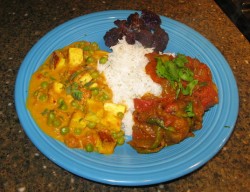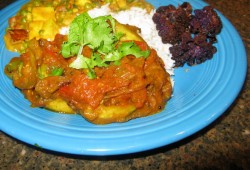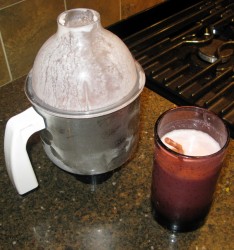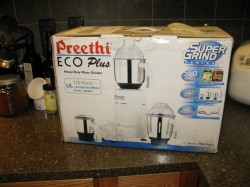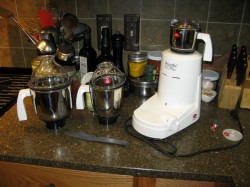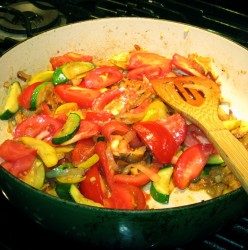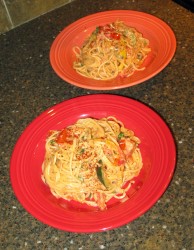Meatless Monday: Aubergine and Courgette Curry
When you want to eat delicious vegetarian food, my advice is always to look into recipes from cultures where vegetarianism is not considered to be particularly special. Places like India, Thailand or China, where lots of people choose to be vegetarians for many reasons–economic, spiritual and health included–have developed vegetarian cuisines that feature dishes which are sensual, delicious, satisfying and absolutely beautiful.
I must admit to being particularly fond of the vegetarian dishes of India, and that is why I chose to feature a new recipe for a curry I invented and cooked at least once a week, sometimes twice, last summer when I was the chef at Restaurant Salaam. I created it to feature the creamy-textured Asian eggplants and courgettes grown by Star Hamilton of Shade River Farm here in Athens, and it was once again her produce that I used to recreate it in my own home kitchen.
I did do a few things differently–for one thing, I wasn’t cooking with five to ten pounds of produce at a time, and for another thing, I didn’t use canned tomatoes–I used fresh ones mixed with a can of crushed tomatoes. Fresh tomatoes make it all so much tastier.
I also added an optional South Indian touch which I never did in the restaurant: I thickened the curry and added a further level of flavor by adding pappula podi to it at the very end of cooking.
Pappula Podi–which I call Indira’s Magic Powder, because it was Mahanandi’s Indira who introduced me to this amazing food/seasoning/magical condiment–is something that I have in my kitchen all the time these days. I make it by the batch, following Indira’s recipe and I keep it in a tightly covered jar next to my stove. I not only use it in cooking, but I sprinkle it over steamed basmati rice along with a drizzle of ghee. Stirred together, this makes a delightful light breakfast or lunch in the summer, and I have eaten it as a snack in the night if I have been up with Kat or one of my quilts and need something to quell the hunger just before bed so that I can sleep.
I have to admit to loving the way it makes vegetarian curries taste, especially ones that have eggplant and tomatoes in them. The toasty chickpeas add a richness to the curry sauces that goes perfectly with velvety tomatoes and silky eggplants. Pappula podi really just is magical. I highly suggest that you get the ingredients and make yourself some and try it out in your kitchen. It is wonderful stuff. (Also, sprinkling some of those ground up chickpeas in your food adds a bit of protein–something that is always good in your vegetarian dishes.)
Now, if you look at the photograph above, you will see three dishes along with the steamed basmati rice. The redder one is the eggplant and courgette curry. The one with peas is Mattar Paneer–which I have grown to absolutely adore, even though I grew up hating peas intensely. The third one, the purple colored one, is roasted purple cauliflower with ghee, mustard seeds and cumin. I got the idea for that dish a few nights ago when I was thinking of how to cook purple cauliflower so that the color would stay intact–cooking it with water makes the color fade because anthocyanins–the chemicals that color it–are heat sensitive and water soluble. I determined that roasting it would work well to preserve the color–and as you can see, I was quite right.
If you decide that you just have to recreate this week’s Meatless Monday meal in your own kitchen–follow the link above for my mattar paneer recipe, and check at the end of this post for the recipe for the aubergine and courgettes curry. For the cauliflower recipe you will just have to be patient and wait until later this week, when I have a chance to write it up and post it! (It is well worth waiting for, though–Dan and I liked it immensely, though Zak admittedly was less positive. Of course, he doesn’t really like cauliflower!)
Until then–happy Meatless Monday!
Aubergine and Courgette Curry
Ingredients:
3 tablespoons ghee, butter or canola oil
2 cups thinly sliced yellow or red onions
1 teaspoon salt
1 fresh red or green chili pepper—or to taste—I use cayenne—very thinly sliced
2†cube fresh ginger, peeled and minced
3 tablespoons fresh garlic, minced
1 tablespoon whole cumin seeds
1 tablespoon whole black mustard seeds
1 teaspoon turmeric
½ teaspoon ground fennel seed
2 long Asian eggplants, cut in half longways and then cut into ½†slices on the bias
2 young zucchini, cut in half longways and then into ½†chunks
2 young yellow crookneck squashes or yellow-skinned zucchini or small pattypan squashes cut similarly to the zuchinni
1 cup canned crushed tomatoes
2 pounds fresh tomatoes, cored, peeled and cut into wedges
Salt and either Aleppo pepper flakes or freshly ground black pepper to taste
1 tablespoon pappula podi (optional)
1 tablespoon fresh lemon juice
1 cup fresh cilantro leaves, roughly chopped as garnish
¼ cup thin diagonal slices of scallion for garnish
Lemon wedges as garnish
Method:
Heat ghee, butter, or oil in a heavy-bottomed, deep skillet over medium heat. Add onions and stir into a single layer in the pan, sprinkle with salt and cook, stirring until they turn golden colored. Add the chili pepper, ginger, garlic, and whole cumin and mustard seeds and continue cooking until the onions turn medium golden brown and everything is fragrant. Add the turmeric, fennel seed and the sliced eggplants and squashes.
Continue cooking until the squashes become lightly browned on the edges. Add crushed and fresh tomatoes and cook until they wilt lightly and release their juice, but do not allow them to completely break down.
Season to taste with salt, Aleppo pepper flakes or freshly ground black pepper. Stir in pappula podi, if you are using it, and cook until the juice thickens slightly–about two minutes.
Add lemon juice and stir in the cilantro leaves then remove from heat and immediately serve over basmati rice. Sprinkle with the scallion slices and serve with a wedge or two of lemon.
Lassi for My Wee Lassie
So, I have been putting Lakshmi, my new Preethi Eco Plus wet/dry grinder/mixie, through her paces, and in doing so, I decided that I need to make lassi.
I love lassi, which is originally a Punjabi drink featuring yogurt, which can appear in sweet or salty-savory flavors, is a summer favorite of mine, but I have never bothered to make it before. The reason was because I hate my blender–it doesn’t blend anything smoothly at all–unless you are dealing with already smooth stuff like ice cream. It takes forever to crush ice and it never whips anything very smoothly at all.
So, I just left my blender in the back of the cabinet and liked lassi from afar.
Ah, but this does not need to be the case anymore, for the Preethie Eco Plus comes with a 1.5 litre jar which is plenty big enough to make lassi, AND it turns out that the grinding capability of it is plenty strong enough to handle ice and frozen fruits.
Now we come to my recipe. Since I had never made lassi before, I looked at various recipes in my Indian cookbooks, as well as looking at various online sources. Strawberry isn’t really a traditional lassi flavor, but it is popular both here and on the Indian subcontinent, but since I wanted Kat to drink the lassi–which is my one guaranteed, surefire method of getting milk and yogurt in the girl in any amount (other than ice cream!) I wanted to make it with flavors that she already likes. No sense in trying mango on her when she isn’t so sure that she even likes mango yet. (She’s still on the fence with mango. I could eat it every day, but she sometimes eats it and sometimes refuses it. Toddlers.)
Since fresh strawberry season is past here in Ohio, I used frozen organic strawberries, and I neglected to thaw them out before starting. Most lassi recipes use yogurt, and some use milk, while others thin the drink with ice water. I chose milk. A few lassi recipes I have found are based on coconut milk rather than dairy products–considering how good coconut fat (lauric acid) is for developing brains and how much Kat loves coconut, I decided to go against tradition and use both dairy products and coconut milk in my version of the drink.
Two traditional flavoring agents, however, became integral to my lassi–ground cardamom and rosewater. As far as I am concerned, cardamom makes nearly anything better and I love rosewater with strawberries. It adds a depth of richness to their flavor that is hard to place if you are unfamiliar with the flavor, but which is unmistakable if you are an aficionado of good rosewater.
Finally, I used honey for a sweetener–and I used less than many recipes specify. I will give the amount I used, but you can use more or less to your taste. You could also use sugar, but I liked the flowery essence that local wildflower honey added to the drink.
So, how did the Preethi perform when it came to making lassi?
Perfectly. She ground up the ice cubes, and frozen strawberries with just the yogurt added as “lubricant.” No water was necessary. Then, I added everything else in, and within a bare minute, everything was blended into a pale pink, smooth froth of a drink.
How did it taste?
Like something that angels might sip on. Like nectar from heaven. Kat drank an entire cup of it herself and Zak and Dan and I took care of the rest–the recipe makes about 1.5 litres, which is enough for generous but not overwhelming portions for four adults and one toddler.
Strawberry Coconut Lassi
Ingredients:
10 ounces frozen strawberries–thawed (if you remember to)
6 ice cubes
1 quart plain yogurt, whole milk, preferably
3 tablespoons honey or to taste
7 ounces coconut milk (I used Chao Koh brand because it has such a fresh sweet taste and isn’t as rich as Mae Ploy)
3 ounces milk (I used 2%)
1/4 teaspoon freshly ground cardamom seed
1 tablespoon rosewater
Method:
Put the first three ingredients in the blender. Blend on medium speed to crush the ice and grind up the berries. Then, add the rest of the ingredients and starting on medium speed, then ending on high speed, whip the liquid into a delicious, frothy pink liquid.
Serve immediately over ice if you prefer. We drank ours sans ice. If you have any leftovers, which we did, you can put it into a tightly sealed quart-sized yogurt container and keep it in the fridge for a day. That is what we did, and it tasted, if anything, better the next day after the flavors had a chance to meld together.
The Preethi is Here, and She’s Beautiful!
It came today! The Preethi came today–and I am itching to put her through her paces.
Yeah, I personify my tools–and this one seems to be very femail to me. It may be the shapes of the three jars–yes, THREE jars! Or it may be the name of the company, Preethi, which sounds feminine to me, and is a rather pretty sounding name at that, but for whatever reason, this new wet/dry grinder/mixie (which I can apparently use to churn my own butter!!!!) is a female.
I think I am going to name her Lakshmi–after the Goddess of abundance, prosperity, generosity and courage–I have a small statuette of Lakshmi in my kitchen, near my statue of Ganesha. (I named my rice cooker after Ganesha, btw.)
I have been reading the instruction manual, but have not yet viewed the instructional DVD–yeah, a DVD. Maybe it will demonstrate the churning of butter. (Mmmm–butter made from our own local Snowville Creamery cream!)
I think I am going to love the three different sizes of jars–one of the problems I always had with the Sumeet was that it wasn’t quite big enough to do a really large batch of Thai curry paste or a whole lot of browned onions for a big batch of Indian curry. I like that I can choose which size jar I need for grinding or mixing or churning whatever it is I am working on. There are ones big enough to do idli or dosa batter–which is great–that means I can finally learn to make these South Indian treats!
Look for a full report soon after I have had a chance to put Lakshmi through her paces–until then, happy cooking!
My Foodie Summer Reading Pile
Summertime is the time for reading.
Well, in truth, every season is the time for reading.
In the summer, you can lounge by the pool or loll on a blanket on the beach and devour a good book from behind movie-star sunglasses. Or, you can be like me as a kid, and climb up in a tree and park yourself against a good sturdy branch like a lioness sleeping off a gazelle feast and instead of snoozing, devour books that you hoisted up the tree with a basket-pulley system.
But winter is perfect for reading, too. Long, cold, snowy nights are perfect for curling up on the couch, with a mug of hot mulled cider, wrapped in a soft old quilt, engulfed in a book.
Spring is good, too–you can listen to the patter of gentle spring rain on the windowpane while a book takes your mind on journeys your body likely never will experience.
And then there is autumn–a nice cool crisp morning when the sky is brilliant cerulean and the leaves are a blaze of russet, gold and orange is perfect for sitting on the porch with a cup of coffee and a book to read while listening to the calls of blue jays and mockingbirds.
Of course, all of these idyllic images rely upon the reader having enough time to actually sit down and read–something that I find myself lacking a bit these days, but dammit–I really do intend to read this pile of books.
So, what is in my summer-reading pile?
The titles of interest to foodies (I admit to also having a few psychology texts, parenting tomes, quilting books and books of Fortean interest in my pile, but I am sparing my readers from having to hear about them) are as follows:
Shark’s Fin and Sichuan Pepper: A Sweet-Sour Memoir of Eating in China by Fuschia Dunlop. The truth is, I have had this book forever. Ever since it came out in hardcover, and I have tried to finish it about three times now. (That’s why it is sans dustcover in the photo–Kat long since denuded the book and destroyed the fragile paper, which is a shame because the cover image of the author drinking soup is quite fetching.) And my statement that I have tried to read it three times is really unfair, because it makes it sound like the book is boring, which it most certainly isn’t. Dunlop, the author of two of my favorite Chinese cookbooks ever, is a great writer, and her remembrances of living, working and learning cookery in China are filled with the flavors, sounds and colors of that unfamiliar, but fascinating world. The reasons I haven’t finished it have more to do with me and my lack of focus than they do with Dunlop and her storytelling ability. This time, I swear I will finish it, for real, and then write a right and proper review of it here.
My China: A Feast For All The Senses by Kylie Kwong Yeah, I’ve had this book forever, too. It is a gorgeous, oversized coffee-table tome of a cookbook, and is filled with photographs conveying the sights, sounds and flavors of China as seen through the eyes of Australian chef and restaurateur Kylie Kwong. I have drooled over the pictures and scanned the text, but have I read it or cooked from it? No. A situation I am bound and determined to remedy.
Serve The People: A Stir Fried Journey Through China by Jen Lin-Liu Yes, this is another memoir/travelogue/eatalogue of an individual who goes through China, seeing it through the eyes and stomachs of her people. Do we detect a theme in Barbara’s reading for this season? I think that we do. Right now you must be thinking that I have a one track mind, but that just is not so. As I noted before, I am also reading about child-rearing, quilting and Bigfoot, so you cannot say that I just want to read about other people traveling to China and eating their fool heads off and writing about it and am living vicariously through them. I resemble that comment, thank you very much. No, seriously, this looks like a fun read from a Chinese-American journalist, born of Taiwanese parents who spends years living and working in Beijing and Shanghai, and while there finds a love for Chinese food and culture. What’s not to like, really?
Chop Suey: A Cultural History of Chinese Food in the United States by Andrew Coe This book just came out, but it looks good to me. It is so new that there are no customer reviews for it on Amazon, so I have to admit I bought it just because I have read Coe’s writing in Gastronomica and liked his writing style. That, and I am fascinated with the subject matter, which will most likely include the development of the Chinese restaurant as a mainstay of American food culture–a story which I find endlessly fascinating, in large part because I have spent plenty of time eating and working at such establishments.
The Food and Cooking of South China by Terry Tan I just got this book yesterday, and boy is it a keeper! The photographs are enticing to say the least and there are recipes for delicacies I have never heard of before–including pork and nut dumplings–how can that be bad–and steamed chicken with ginger wine. Again, how can this be bad? Look for a full review with recipe presentations later in this month or next for this book–it is definitely a keeper.
So, there is my foodie reading for the summer.
What books are in your stack of foodie reading for this season? I need to know so I can add even more books to my pile!
Meatless Monday Recipe: Spaghetti With Courgettes, Tomatoes and Chevre
Pasta is an easy vegetable-based dish to concoct, especially now, during the fecund summer months when fresh vegetables and herbs are bursting out of every bit of tilled soil in the country, fairly begging to be made into something delicious.
If you think about it, many of the classic pasta sauces of Italy are based on vegetables. Look at the classic marinara sauce–that lovely red sauce that engulfs nearly every Italianesque dish we Americans can think of. It is filled with the goodness of summer–ripe crimson tomatoes, onions, garlic, sometimes peppers, and most certainly fresh herbs like basil and oregano. Made from scratch, marinara tossed with some spaghetti and topped with freshly grated or shredded Parmesan cheese is a perfectly amazing vegetarian meal.
But, let’s go beyond marinara here–and look at the possibilities of making other pasta sauces based on other vegetables, just as they do all over Italy in the summer.
Courgettes, (which is just the French word for wee summer squashes like yellow crookneck and zucchini–and sounds more appealing than “squashes) are all over the markets and gardens of the United States right now and when combined with some fresh tomatoes, caramelized onions, garlic and fresh basil, make a lovely pasta sauce.
When making a sauce for pasta out of courgettes, I always choose very young small ones which have very thin skins, fine, tightly compacted seeds and creamy yet somewhat dry flesh. Larger, older squash tend to have thicker, tougher skins, larger, less easily digestible seeds and their flesh is spongier and filled with more water. When you saute older squash, they release way more water, and the seeds fall away from the flesh and the whole thing can make a soggy mess.
On the other hand, if you saute young courgettes, the flesh and seeds stay together, they release a minimum of water and they will brown nicely on the edges and go velvety tender in the center. The browning brings out the naturally sweet flavor of the little vegetables and their texture makes them soft enough to wrap around with the pasta, but not so soft that they fall apart and are lost in the sauce.
I add the fresh tomatoes near the end of cooking so that they just soften a bit and become somewhat melty without losing their cohesive shapes–since I don’t peel the tomatoes (which is a personal choice–if you want, you can peel yours, but I like the extra texture of the peels in this dish), I very much want the tomatoes to stay separate from the sauce and not just fall apart into it.
Now we come to the chevre–you can not use it if you want to, but I think that melting the creamy goat cheese into the sauce brings the separate vegetables and herbs into a cohesive dish. The creamy richness of the tangy cheese also makes the pasta a little more filling–just as some Parmesan cheese does with marinara sauce. It doesn’t take much chevre to turn this sauce velvety and amazingly creamy–so don’t overdo it. I used only about two to two and a half ounces of the amazing locally made chevre from Integration Acres to make a sauce that clung to each strand of spaghetti and helped the vegetables twirl right up on the fork with the pasta in each bite.
Just two squashes, six small fresh tomatoes, a large onion, some garlic, herbs and a little bit of wine and canned tomato sauce combined with fresh chevre and spaghetti makes a fully satisfying summer vegetarian meal that is filled with all the great flavors of the summer garden. I cooked this for Morganna, Kat and I, but I ended up feeding two extra people with the leftovers–Morganna took them home to her housemates and apparently, they were gobbled up before they even cooled off all the way. No microwave needed!
Spaghetti with Courgettes, Tomatoes and Chevre
Ingredients:
3 tablespoons olive oil
2 cups thinly sliced white or yellow onions
1 teaspoon salt
1 teaspoon Aleppo pepper flakes or black pepper to taste
1 small zucchini, sliced longitudinally, then cut into thin slices on the bias (into little half-moon shapes or near-crescents)
1 small yellow crookneck squash, cut the same as the zucchini
2 tablespoons finely minced fresh peeled garlic
1/4 cup dry red wine
6 small tomatoes, cored and cut into 6-8 wedges each
1/3-1/2 cup canned tomato sauce
2-2 1/2 ounces fresh chevre
salt to taste
1/4 cup minced fresh basil or a mixture of fresh herbs like basil, oregano, flat leaf parsley, and marjoram
3/4 of an 16 ounce box of spaghetti, cooked and drained
Method:
Heat the olive oil in a heavy-bottomed skillet and add the onions. Sprinkle with the salt and cook, stirring, until they turn a deep golden color.
Add the Aleppo pepper flakes or freshly ground black pepper, and the courgette slices. Sprinkle the squashes with the garlic. Cook, stirring, until the onions turn brown and the courgettes release their juices and brown on the edges, with the flesh turning golden.
Deglaze the pan wit the wine, and cook, stirring until the alcohol boils off and just a bit of reddish purple juice is left. Stir in the tomatoes and the tomato sauce, and cook, stirring, until the tomato skins wrinkle and their flesh softens and the liquid in the pan thickens slightly.
Turn off the heat under the pan. Break up the chevre into chunks and stir into the sauce, and keep stirring until it melts into the sauce. Taste for salt and correct seasoning, then sprinkle in the herbs.
Stir and toss the spaghetti into the sauce, and twirl into warmed pasta bowls. Sprinkle with a bit of extra minced herbs and Aleppo pepper or freshly ground black pepper to garnish.
(serves about four adults and one toddler)
Powered by WordPress. Graphics by Zak Kramer.
Design update by Daniel Trout.
Entries and comments feeds.

